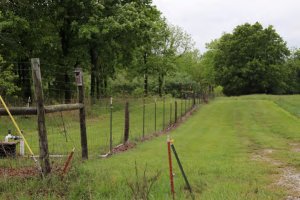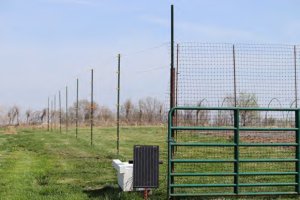AgEBB-MU CAFNR Extension
Green Horizons
Volume 25, Number 2
Spring 2021
Deer Fencing - Protect your plantings
Barry Eschenbrenner, Co-superintendent, Horticultural and Agroforestry Research Center (HARC)
 |
| Elderberry Fence (not electrified) |
We grow many crops and trees at the MU Horticulture and Agroforestry Research Center (HARC) in New Franklin, MO. We have found that if we don't protect the new plantings, the deer will either eat or "buck-rub" (scrape) the crops/trees. We have tried several different fence styles here at HARC. Some electric, some not. We have had success with all of them, it just depends on what you prefer. They all basically use the same amount of support posts, so that is kind of a wash, no matter what system you use. We have some great fence here at the HARC farm. Woven wire with smooth wire on top can be electrified. We have observed that deer just jump through if the fence is not "hot". We electrify fence depending on the activities and use in that particular area of farm.
 |
| Mesh Fence (not electrified) |
The first deer fence we put up at HARC was a heavy duty polypropylene mesh from A.M. Leonard. We went with 7 ½' tall fencing. It works well to keep the deer out. We didn't buy any of the accessories that A.M. Leonard sells. We used material we had on the farm (wire, 2 x 6's, connectors). If you use their accessories, we are confident you would also have a great deer-proof fence. This fence had the second highest cost of all the fences we have constructed. It has the lowest maintenance, is not electric, and is a great wildlife protector.
When using hot wire, a good fence charger is a must. There is always maintenance with this system, you have to check the fence regularly to make sure it is not "shorted out". When animals get into the fencing, they can knock it down. We consider it a daily chore to check the fences. Ninety nine percent of the time it's fine, but you do need to keep checking. The drawbacks of the polypropylene fence are in its appearance. It is difficult to keep the fence tight. The plastic gets warm and then looks "saggie". It is plastic, so we really don't know how long it will hold up in the sun. This is the 5th summer for our first fence, it is still working.
 |
| Watermelon Fence |
Because we do not like the appearance of the polypropylene mesh, we started building "ploy wire" electric fencing. The poly wire is great to work with, it's quick to construct, easy and effective. As an electric fence, it is always "hot". You can put wires at different spacing because it is very easy to change the position of the insulators. Your posts for this system are T-posts for the fence line and oil pipe for the corner post. We use a 10' T-post. The number of wires used is up to you. We went with 7 wires, the wires closer to ground are closer together. That is for raccoon control. Drawbacks to this system include the need for ongoing fence maintenance and the posts are tall, so harder to drive into the ground. To date, this fence is keeping deer out, the jury is still out relative to raccoon exclusion.
 |
| Hog panel with hot wire fence |
The most recent fence we built at HARC is a combination panel / electric. We use a hog panel at the base and poly wire on top. Hog panels are very stable and the wire is heavy. It is rabbit / small animal proof. This probably our best fence for appearance and animal control. It is also the most expensive.
If you already have a normal height cattle fence, we have come out about 4' away from that existing fence with a single wire electric fence. Deer seem to have a depth perception problem, so putting two fences about 4' apart does seem to deter the deer. We refer to this as a "kicker wire". This would be the least expensive and least effective option.
The prices of these different systems vary and can change. A good rule of thumb for an acre of reliable deer-proof fence would be around $2,000. That does not include labor.
This is a general overview of the different fence types used at HARC. If you need specific measurements and costs, please contact us. We plan to creating "fence videos" this summer and we will post them on the Mizzou Agroforestry YouTube channel.
